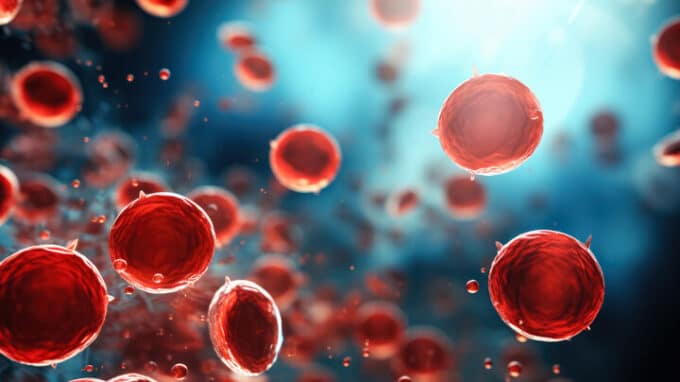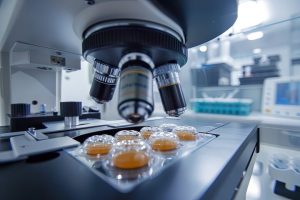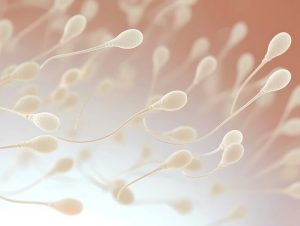Different types of cells—such as heart, liver, blood, and sperm cells—have properties that help them perform their unique tasks in the body. In general, these properties are hardwired. Without intervention, a heart cell does not spontaneously transform into a liver cell. However, researchers at the University of Pennsylvania School of Veterinary Medicine, in collaboration with colleagues at the University of Texas at San Antonio and the Texas Biomedical Research Institute, have succeeded in modifying blood cells from marmosets to give them the flexibility of stem cells. They then induced these stem cells to take on the characteristics of sperm precursors.
The results—the first in marmosets, a small species of monkey—open up new possibilities for primate biology research and the development of novel assisted reproductive technologies such as in vitro gametogenesis, a process for producing germ cells, sperm, or egg cells in a laboratory dish, similar to in vitro fertilization, in which an embryo is created outside the human body.
Marmosets are a Valuable Model for Reproductive Biology Studies
“Scientists know how to produce functional sperm and eggs from induced pluripotent stem cells in mice, but mouse germ cells are very different from human germ cells,” said Kotaro Sasaki, assistant professor at Penn Vet. “By studying marmosets, whose biology is more similar to our own, we can bridge this gap.”
To understand how germ cells are produced, the researchers first studied germ cell precursors from marmoset embryos, which had never been characterized in detail for this species. They found that these early-stage cells, called primordial germ cells (PGCs), express specific molecular markers that can be tracked over time. Single-cell RNA sequencing of these cells revealed that PGCs expressed genes characteristic of early germ cells, as well as genes associated with epigenetic modifications that regulate gene expression. However, PGCs did not express genes known to be activated later in the germ cell development process, when the precursor cells migrate to the ovaries or testes to complete maturation.
Their findings are “consistent with the idea that marmoset germ cells undergo a reprogramming process,” says Sasaki, who “turns off” certain markers and allows the PGCs to go through the stages of germ cell development. The patterns the researchers observed in marmoset cells were very similar to those found in both humans and other monkey species, but differed from those in mice – another reason why marmosets could be a valuable model for reproductive biology studies.
How Sperm Precursors are Formed
Armed with this information, the team set out to artificially replicate the developmental process in the laboratory. The first step was to convert blood cells into induced pluripotent stem cells (iPSCs), which retain the ability to develop into a range of other cell types. After many trials and errors, and applying insights from studies in mice, humans, and other organisms, Seita, a postdoctoral researcher in Sasaki’s lab and one of the lead authors, devised a strategy that allowed him to generate and maintain stable cultures of iPSCs. A key to success was the addition of an inhibitor of the signaling pathway controlled by the Wnt protein, which is involved in a variety of cell functions such as cell differentiation.
The next step was to transition from iPSCs to germ cell precursors. Here, too, extensive experimentation was required to develop the protocol for this transformation. The method that worked best was to add a cocktail of growth factors to successfully induce 15 to 40% of the culture to take on the characteristics of these germ cell precursors.
In a final phase of the study, the research team induced these lab-grown cells to take on the characteristics of later-stage germ cells. Based on a method that Sasaki and his colleagues had previously developed in human cells and published in an article in Nature Communications in 2020, they cultured the cells together with mouse testicular cells for one month. The result was successful growth, with some cells beginning to activate genes associated with sperm precursors at later stages.
Assisted Reproductive Technology
The development of new approaches to marmoset research is enabling teams at Penn and the University of Texas at San Antonio—as well as the scientific community in general—to use this species as an important research model. Marmosets, for example, have cognitive functions that are similar to those of humans in many ways and could therefore lead to new insights in neuroscience.
For Sasaki’s group, which is primarily interested in the development of the reproductive system, marmosets represent a new starting point for research into normal and abnormal development and fertility. “When considering the clinical applications of an assisted reproductive technology such as in vitro gametogenesis, there are many ethical, legal, and safety concerns that could arise,” says Sasaki. “We definitely need a good preclinical model that we can study before moving on to clinical application in humans.”






